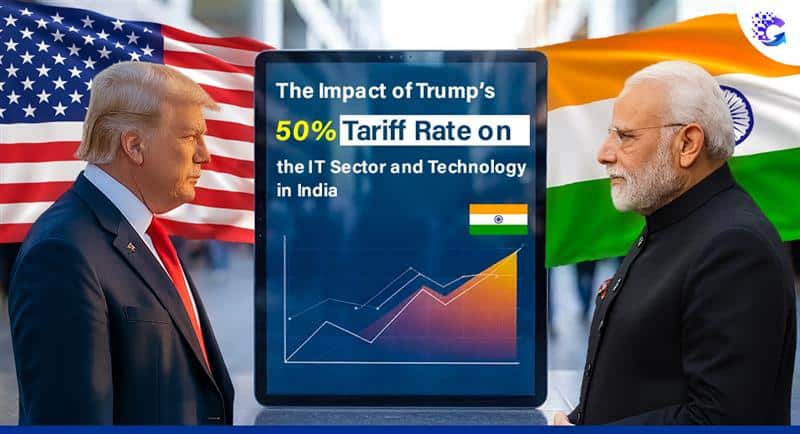Over the past few days, the world economy has been through turbulence due to the refurbished tariff rate announced by US President Donald Trump. On 6th August 2025, President Trump officially announced tariff rates for different countries, including India, Pakistan, China, the EU, Canada, Brazil, and South Africa.
With these newer tariff rates, some nations are deeply affected, while others are marginally. India is a country that faced President Trump’s wrath, as he imposed a 50% tariff rate due to India’s business proximity to Russia.
However, could this be a turning point for Indian industries, especially the IT & Tech sector, rather than just another challenge? How will the top IT sector in India, along with other services, thrive in this transformative environment?
Let’s explore.
1. Why has a 50% U.S. tariff on Indian goods become such a flashpoint?
On 6th August, President Trump doubled tariffs on Indian exports from 25% to 50%, citing India’s ongoing imports of Russian oil as the rationale. He also mentioned that there will be no further trade negotiations until the dispute is resolute from the Indian side.
This initiative escalates already tense geopolitical dynamics and portrays a clear indication that Indian exports (including tech and electronics) are under immense pressure and under heightened security.
2. Which sectors in India stand most exposed to this tariff escalation?
One analysis suggests that India’s real GDP growth could take a cumulative hit of around 60 basis points, 0.3 points from an earlier round, and another 0.3 from this latest escalation. The electronics sector, in particular, stands to lose between $20–30 billion in future business opportunities, especially if tariffs extend to semiconductors.
3. Is the Indian IT services sector directly impacted by these tariffs?
Interestingly, popular IT companies in India aren’t directly subject to the new U.S. tariffs, which apply to goods, not services. Yet, the EY India leadership warns of “substantial” ripple effects.
- Rising U.S. input costs may lead American companies to trim discretionary tech spending.
- Increased uncertainty around workforce mobility and evolving digital taxation structures could reshape cross-border pricing and delivery models.
Recommended reading: IOT Security Challenges in 2025: Are We Really Safe?
4. What indirect symptoms are showing up so far?
Immediate aftershocks are evident. USA clients are now completely aware of the situation, and they are scaling back non-essential tech investments. With AI transformation and macroeconomic uncertainties, the IT sector will face challenges and volatility on various fronts.
Several analysts expect a submissive growth in Q4 FY 2025. This highlights macroeconomic pressures, digital transformation, AI integration, and seasonal weaknesses.
5. How is India responding economically and diplomatically?
India has taken a stand against this baseless tariff rate. Our nation firmly rejected the move and described it as “unfair, unjustified and unreasonable”. We also mentioned that discounted Russian oil strengthens our energy security. This move was not due to any geopolitical alignment.
RBI Governor, Sanjay Malhotra, on 6th August 2025, stated that India’s economy is stable and doing pretty well. He challenged Trump’s “dead economy” taunt. He also mentioned that India is a key contributor to the global economy.
Moreover, Jonathan Schiessl, a market expert, offered a more optimistic forecast, arguing that India’s strong domestic consumption, diversified services base, and robust macro fundamentals provide resilience against U.S. tariff policy shifts.
6. Is there a strategic value here, a regulatory “deewar” India can climb?
Amitabh Kant called Trump’s tariffs a ‘once-in-a-generation’ chance, India’s Agneepath moment to scale the tariff deewar. He also mentioned that India has the capacity to strengthen and reinforce its domestic industrial capacity, amidst this external turbulence.
Many industrialists and economists are viewing these tariff rates less as existential threats and more as catalysts for refurbishing their own economy to diversify markets. India will certainly fortify its electronics manufacturing strength and spend more on technological innovation.
7. What can Indian IT firms and the broader tech ecosystem do?
- Adapt and pivot: The top IT companies in India are opting for hybrid models. They are spreading their geographic client base and integrating AI to upscale their infrastructure. They are trying to equip themselves for these globally fragmented markets.
- Build domestic resilience: Companies are prioritizing more initiatives like “Make in India’ and ‘Atmanirbhar Bharat’ to strengthen their in-house supply chains. These initiatives will help them lessen their over-reliance on external marketplaces.
- Embrace diversification: Opportunities are there in the markets of South Asia, Africa, Latin America, and other thriving nations. India’s Commerce Ministry is trying to make partnerships with these countries and expand its trade territories.
8. What about the broader geopolitical landscape?
Trump’s whimsical tariff escalation has provoked pushback beyond Indian borders. Russia condemned this act and supported New Delhi’s right to choose trading partners. Other nations like China, BRICS, etc., urged flexibility and strategic autonomy for domestic growth and development.
9. Final thoughts and where Grizon Tech fits in
Although this 50% tariff shock deals a tectonic blow, it also gives the best IT service companies in India the opportunity to showcase their strengths and mitigate the gap by adopting the right strategy.
- Strengths: A versatile services industry, rapid AI integration, domestic policy levers, and growing worldwide confidence.
- Challenges: Trade dependencies, tariff exposures, and geopolitical volatility.
Grizon Tech, an emerging tech innovator or service provider, exemplifies the kind of agile enterprise that turns commotion into prospect. By:
- Helping clients to target beyond the USA market,
- Focusing more on AI, automation, and its usage,
- Prioritizing operations domestically while serving global markets,
As the best IT service company in India, we not only help clients to survive in this tariff-induced market but also guide them on how to lead the next wave of Indian Tech transformation.
For any kind of IT consultation, drop your query to us. Our experts will respond with the best solutions.






